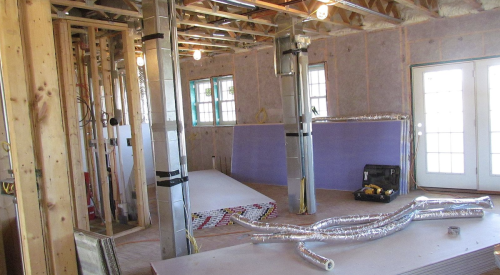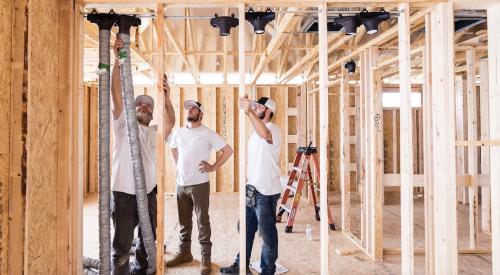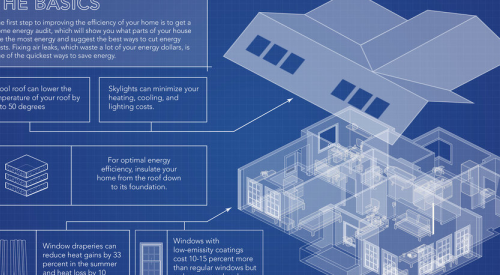| Single-family homes at Carillon Lakes range from 1,680 to 2,322 square feet and are priced from $196,990 to $217,990. Since models opened in spring 2001, builder Cambridge Homes has sold 100 houses. |
| To increase energy efficiency, ductwork at Carillon Lakes is in conditioned space rather than the attic. Above, Cambridge dropped the ductwork in the entry area and enclosed it in soffits. |
| R-11 fiberglass wall insulation is now standard in Carillon Lakes basements, which previously were not insulated. Interior basement insulation helps create a tightly sealed thermal envelope. |
After 18 months of testing, analysis, retrofitting and retesting, Cambridge Homes of Libertyville, Ill., can add another notch to its quality belt. The builder partnered with the Consortium for Advanced Residential Buildings and Steven Winter Associates, a Norwalk, Conn., architectural and engineering firm, to achieve Energy Star certification at a new active-adult community. Carillon Lakes is CARB’s first project in the Chicago area and Cambridge’s first Energy Star project. It’s also one of the largest developments SWA has taken on, with more than 900 homes planned.
CARB is a group of designers, home builders and product manufacturers that have joined the Building America program, which uses a systems engineering approach to produce houses that are high-quality, affordable, and energy- and resource-efficient. Led by SWA, the CARB team is building a series of prototype townhouses and developments to test these goals in the marketplace.
All CARB projects are Energy Star-rated, and it was this component of Building America that Cambridge elected to pursue. Two years ago, Tom Arndt, Cambridge’s vice president of operations, met Steven Winter at the International Builders’ Show after Winter’s presentation on Building America. “I asked [Steve] if we could do some work together, and he was very interested because CARB had no presence in Chicago at that time,” Arndt says. “I said I wanted to find, with his help, something that was of value to our buyers and a fairly significant but not terribly unattainable goal.”
Acquired by Arlington, Texas-based housing Giant D.R. Horton Inc. in January 1999, Cambridge Homes is a big builder in its own right, producing approximately 1,200 units a year. Cambridge chose Carillon Lakes in Crest Hill, Ill., (about 35 miles southwest of Chicago) for the Energy Star program because residents are on fixed incomes and therefore very concerned about energy costs. They also are very sensitive to temperature fluctuations.
“We’ve come to realize that the comfort of the home is really important to an older buyer,” Arndt says. The builder’s objective was to have Energy Star certification by the time models opened in the spring of 2001.
Getting the Bugs Out
Arndt prepared for the Energy Star effort by visiting CARB projects in other parts of the United States, learning about problems builders had experienced and which trades had the most difficulty working within Energy Star requirements. Arndt estimates that Cambridge and SWA met 10 times during the next year-and-a-half, with two to six people attending each time. The HVAC contractor and other trades were brought into the meetings as Carillon Lakes drew closer to the production stage.
Architect Christine Bruncati explains that when SWA works with builders to help them improve energy efficiency, sometimes the firm designs new housing from scratch, and other times it modifies existing product. The latter was the case at Carillon Lakes, where model homes were already under construction when the Energy Star process began.
| Third-party home energy raters conduct blower door tests to measure air infiltration at each home in Carillon Lakes, making sure it meets Energy Star requirements. |
Bruncati says that bringing an entire community up to the Energy Star level was “a pretty ambitious thing for Cambridge to do because it didn’t only involve changing the specification for their windows. There were some other changes that involved the construction process, so there was a bit more of a learning curve for them. What we always try to remember is that if the [trade contractors] don’t understand why they’re being asked to do certain things, then they’re less motivated to do it.”
SWA engineer Robb Aldrich visited the site several times to perform tests on the models. During his first trip, Aldrich tested thermal envelope leakage, duct leakage and HVAC performance. The results, he says, “were decent. The envelopes were fairly tight, and the duct systems were adequate.” There was room for improvement, though.
Back in Connecticut, SWA reviewed the test results and blueprints, and built computer models to measure the impact of varying specifications on energy performance. Bruncati says this is standard for SWA, although the firm does not typically handle projects as large as Carillon Lakes.
SWA uses REM/Design, a software program that calculates heating, cooling, hot water, lighting and appliance loads, consumption and costs for single-family and multifamily designs in more than 250 American cities. REM/Design automatically analyzes the energy and economic performances of various features including envelope insulation, air-leakage control, duct-leakage control, windows and mechanical ventilation. The software also sizes heating and cooling equipment, and identifies cost-effective energy improvements.
“We will run the builder’s standard practices through REM/Design and see what they need to do in order to make Energy Star,” Bruncati says. “And sometimes we’ll take them beyond Energy Star if they’re interested in that.” For Carillon Lakes, SWA also tweaked mechanical systems so that the ductwork would operate more efficiently.
The new energy specs affected five major areas: basements, windows, thermostats, ceilings and ductwork. In the single-family homes, R-11 fiberglass wall insulation was added to previously uninsulated basements. Dual-pane, low-e, vinyl windows replaced the existing windows, which had low-e glass only. The basement insulation and new windows allowed Cambridge to reduce the size of air-conditioning systems by a half-ton for every model type (the A/C units, which were previously 2 to 31/2 tons, now range from 11/2 to 3 tons). Programmable thermostats were installed, and ceiling insulation was upgraded from R-30 to R-38.
“In all the houses they had some ductwork through the attics, which can be a big energy hit,” Aldrich says. “So we worked out a system of soffits and dropped ceilings to bring the ducts into the conditioned space where necessary.” By that time, however, the framers had already completed work on the model homes, and the cold-air returns weren’t sealed off from the attic. “When it was tested, the duct leakage was just outrageously high,” Aldrich says. “The subs had to go back in and seal the ducts and go up in the attic and seal off these soffits from the attic. That fixed the problems.”
The revised specifications also included something the trade contractors had never used: transfer grilles, which are designed to keep an adequate supply of air circulating into and out of a room. Where it wasn’t possible to have hard-ducted returns, transfer grilles were installed high and low on opposite sides of a sealed wall cavity. “In the attached units, we provided a central return grille for the main living area and a ducted return to the master bedroom,” Aldrich says. “In the secondary bedrooms, where it was convenient, we had ducted returns. But usually we specified high/low transfer grilles.”
Arndt says the transfer grille concept is simple. “The minute HVAC contractors see it, they understand it, but until they do it a time or two, it may not be totally clear. It was definitely one of the problems they had to work through.” Once SWA tested the grilles with bedroom doors both open and closed, “it was fine,” Aldrich says. “The contractor had been a little skeptical, but he was surprised by some of the results. He was pretty happy about it.”
Scott Hickey, director of south Chicago operations for Cambridge, says problems that arose in the field were largely a result of differences between the models and the production homes. Cambridge offers a variety of floor-plan options at Carillon Lakes, such as sun rooms and sitting rooms in master suites, and the framing of each home varies according to the buyer’s choices. “It took awhile to work the bugs out on exactly where we were going to put the transfer grilles, where the soffits were going to be and what size they needed to be,” Hickey says. “Some transfer grilles were over doorways, so we had to make sure that the headers were sized properly. That was a big coordination effort between the carpenter and the HVAC contractor.”
At one point, Hickey says, the carpenters started to pre-build the soffits only to find out that they weren’t deep enough to accommodate the ductwork and electrical wiring for lighting fixtures and smoke detectors. “So then we had to change the soffits,” he says.
By comparison, insulating the basements was easy. Blanket insulation was attached to the concrete walls with 2@2 furring strips, creating “a nice, clean look for the homeowner,” Hickey says. Other changes, such as the setback thermostats, new windows and upgraded ceiling insulation, also went off without a hitch.
Once the models were completed, SWA personnel met with home energy rater Jerry Thatcher at the site. They observed Thatcher’s tests and recommended a few adjustments to reduce duct leakage. At the start of production, the SWA team also inspected framed houses to ensure that procedures were carried out correctly. “They were always on hand,” Hickey says. “If we had a question or a problem, they were right there.”
Tweaking Time
On average, Energy Star compliance costs Cambridge $1,000 more per house. “The range is probably $500 to $1,500,” Arndt says. “Obviously, the bigger the house, the more it costs.” Hickey says the basement insulation accounts for the biggest portion of this extra cost.
| An anometer is used to take temperature and cfm readings to determine the duct leakage in the home. |
Cambridge has sold 100 homes at Carillon Lakes since the models opened. Single-family homes range from 1,680 to 2,322 square feet and are priced from $196,990 to $217,990. Townhouses range from 1,107 to 1,694 square feet and are priced from $145,990 to $181,990.
Arndt says the benefits of the Energy Star program “are really wonderful. Our homeowners greatly appreciate any amount of money they can save on utility bills. The fact that we can provide a house that’s more comfortable to live in and that’s cheaper to live in is a significant benefit to our buyers.”
SWA will continue to monitor the performance of finished homes, tweaking plans and procedures as needed. Next spring, once Carillon Lakes residents have experienced a full cycle of seasons, the builder will hold focus groups to obtain customer feedback.
Cambridge is fine-tuning other energy-related building techniques, such as the sub-slab distribution system. Common among Chicago builders, this system runs any ductwork that isn’t in the ceiling underneath the slab. “We’re monitoring performance because there’s some concern about energy efficiency and air quality with ductwork below slabs,” Aldrich says. SWA is also developing a slab edge insulation detail that will provide a thermal break, keeping out cold winter air that radiates through concrete and cools the perimeter of a slab-on-grade home. “We’re trying to get a detail that will be easy to pull off and not very expensive,” Aldrich says.
SWA is working with Cambridge to achieve Energy Star certification at two other suburban Chicago communities, The Glen at Glenview Naval Air Station and Forest Glen in Carol Stream, a multifamily development for active adults. The same specifications worked out for Carillon Lakes will be used at The Glen, with newly designed mechanical systems. In addition, SWA is designing a new product line for Forest Glen that will include 2@6 framing; high-performance, low-e windows; open-web floor joists to accommodate ductwork; and high-efficiency sealed combustion furnaces.
Cambridge has obviously made significant progress, but Arndt says the work is far from over. “Our goal was to be a success working with Building America and in doing some things differently in our market. Now there’s a lot of other things we can start looking at through Steven Winter.”












